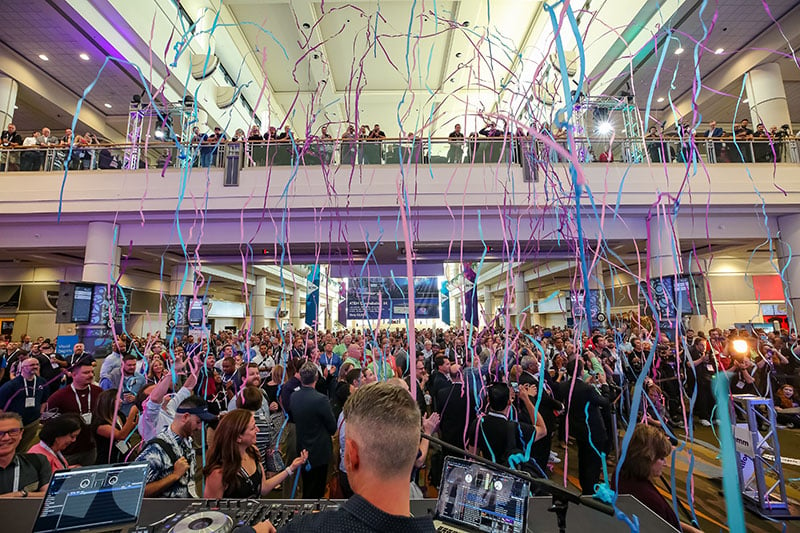How Facebook Manages Collaboration During COVID-19
How are global companies with huge office footprints handling a massive increase in working from home? Liam McDonough, Lead Collaboration Engineer at Facebook; Alfredo Ramirez, CEO of Vytopa; and Matt Stevenson, Senior Solutions Engineer, Vytopa, shared how one of the largest companies in the world is handling remote collaboration, and what they see coming as staff starts to return to its famously well-appointed office space.

Even before the pandemic, Facebook was running one of the biggest collaboration networks in the world, including 13,000 connected conference rooms. The office culture is all about collaboration. Chat in real time is the primary conferencing and collaboration method used by the workforce.
Increased Bandwidth and Work-From-Home Tech Support
Before the COVID-19 pandemic, Facebook had a strong work-from-the-office culture. It averaged 14.2 Gbps of video traffic during a normal workday. McDonough’s team concentrated their time and efforts in the office experience. When that went away, they had to adapt and learn quickly.
The typical Facebook meeting in the past consisted of five people in a conference room using zero connections. After the pandemic hit, that changed to a meeting of five people from home making five different connections. That multiplies quickly with such a large company, requiring way more bandwidth. In fact, the company needed five times the amount of bandwidth to support everyone at home compared to when they were in the office. In addition, workers’ home networks had to accommodate their family members’ online activities such as homeschooling and TV streaming. Saturation on these home networks became the new big problem.
Related: Back to the Workplace: Are We There Yet?
For the first time, it was imperative that the company’s tech support help employees fix their home setup issues rather than saying “that’s your home network, that’s your problem.” The company responded by enabling employees to get on the Facebook network at home via hotspot or direct connection. It also provided everyone with a Facebook portal. McDonough’s group provided resources, such as lists of the best routers and common fixes for issues people experience with them.
Tips for Supporting Remote Workforce
Based on Facebook’s recent experience, the following are Ramirez’s top tips for how to support a great technology experience for your remote workforce.
- Diverse User Groups. Create power user groups with diverse users to learn what works. Marketing, IT, VPs, etc., all have different needs, so you need to get the solutions in front of everyone to see what they like.
- Flexibility. A helpful strategy is to give everyone every collaboration software tool they want or need (Zoom, WebEx, BlueJeans, etc.) and then see which one wins in the “marketplace” of employees. Consider everything and anything — even things you once would have said no to.
- Measure, Monitor, and Get Feedback. Facebook is enabling everything for now and looking at the data, especially connection quality and user feedback. It is researching users who keep having bad calls and fixing their issues. That data is used to compare which services are performing. Success is not achievable if staff do not like or do not want to use the solutions.
- Train. Create 1-minute videos that show how to do things without having to call the help desk.
- Service Level Agreement (SLA) and Quick Response Time. Have clear expectations on the help desk response and try to make this as quick as possible. When their first experience with new tech fails, people will revert to using something they already know. Do everything you can to make them successful on the first try.
- Cross-Functional Partnerships. You need buy-in from groups such as the network team, facilities, or whoever is impacted by the rollout.
- No-Pressure Testing. Use the tool to have a virtual happy hour with your friends before having senior level leaders use it for an important meeting.
- Get Endpoints in Their Hands. Use Facebook portals and similar devices. People who have the portal use it more for point-to-point direct dialing.
- Get Audio Right. In Facebook’s analysis of user data, people with good quality audio, but bad quality video, rated the call higher than people with bad quality audio, but good quality video.
Related: Human-Centric AV Design Means Asking Workers for Input
When doing something new, it is always helpful to learn how someone else approached it, especially an innovative and market-leading company like Facebook. To learn more about how to manage conferencing and collaboration during COVID-19, and hear the group’s predictions for the future of the collaboration landscape, watch the full webinar: Managing UC in COVID-19 Era: Lessons From a Global Leader.






